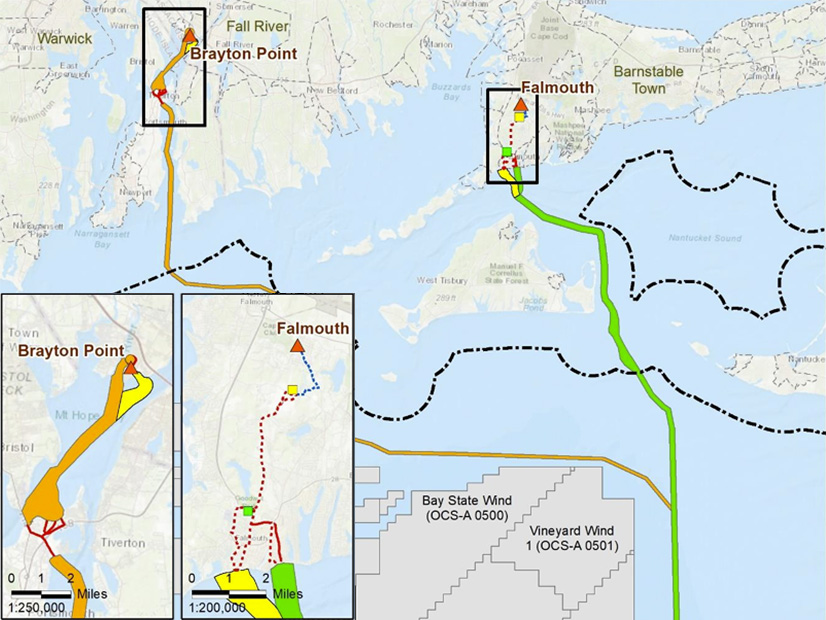The U.S. Bureau of Ocean Energy Management (BOEM) issued the final environmental impact statement (FEIS) for SouthCoast Wind on Nov. 8, bringing the project one step closer to final approval.
The project’s construction and operations plan would allow for the development of up to 2,400 MW of power on a 127,388-acre lease area south of Massachusetts. Rhode Island and Massachusetts recently selected 1,287 MW of power from the project’s first phase of development in a coordinated solicitation. (See Multistate Offshore Wind Solicitation Lands 2,878 MW for Mass., RI.)
SouthCoast Wind developer Ocean Winds, owned by EDP Renewables and ENGIE, predicts that SouthCoast Wind 1 will come online by 2030. It recently received several key state environmental approvals from Massachusetts, where the project will interconnect to the grid.
“Completing this environmental review represents another major milestone in the [Biden] administration’s commitment to achieving clean energy objectives that will benefit local communities,” said BOEM Director Elizabeth Klein.
BOEM plans to publish the notice of availability of the FEIS in the Federal Register on Nov. 15. That will be followed by a 30-day waiting period before the agency can issue a final record of decision.
The agency considered how the project proposal and several alternatives would affect local communities and the environment, qualitatively evaluating benefits and adverse impacts. BOEM conducted isolated impact analyses of the project alternatives as well as cumulative impact analyses, which evaluate project impacts within the context of outside stressors including climate change and other planned offshore wind projects.
Regarding ecosystem and wildlife effects, the report found the proposal would have minor adverse impacts on local birds, bats and sea turtles, and moderate adverse impacts on benthic resources, coastal habitat and fauna, fish habitat, marine mammals and wetlands.
The statement noted that the habitat of several endangered species of whale, including the critically endangered North American right whale, overlaps with the project area.
To limit harms to marine mammals, BOEM identified a preferred project alternative that would remove six wind turbine generators (WTGs) from a part of the lease area adjacent to the Nantucket Shoals, which it wrote is “an area of high biological productivity.”
“The removal of six WTGs in the northeastern edge of the lease area would reduce potential noise disturbance in turbine positions closest to Nantucket Shoals, thus decreasing associated risks to marine mammals, especially [North American right whales], that are known to use this area,” BOEM wrote, adding that the alternative similarly would reduce risks from vehicles in this area.
BOEM found the preferred alternative would have a moderate adverse impact on whales, but noted the possibility of major adverse impacts on right whales due to the species’ small remaining population and the disproportionate impact a single death could have on the species’ viability.
The agency found the proposal would lead to major cumulative impacts on the fishing industry, writing that “some fishing operations could experience long-term, major disruptions.”
The proposal also would affect cultural resources and scenic resources and could have a disproportionate impact on Tribal Nations, BOEM said. The project’s construction also could cause an increase in local air and noise pollution, coastal land use challenges, increased vessel traffic and conflicts with the tourism industry, BOEM found.
The no-build alternative — which accounts for the effects of climate change and the development of other offshore wind projects — also demonstrated many similar adverse effects, BOEM noted.
For benefits, the agency found the project would bring employment opportunities and tax revenue associated with the offshore wind industry, port infrastructure improvements, and emissions and climate benefits for displaced fossil generation.
Offshore wind industry representatives applauded the release of the FEIS, which came at the end of a turbulent week for offshore wind companies in the wake of the U.S. election.
“With its final approval later this year, the U.S. market will have 11 commercial-scale projects either completed, under development, or ready to break ground, representing more American jobs and tens of billions of dollars in economic activity,” said Liz Burdock, CEO of the Oceantic Network.
Burdock gave a nod to the first Trump administration for issuing SouthCoast Wind’s lease and emphasized the project’s potential economic and employment benefits.
Trump took aim at the offshore wind industry in the leadup to the election, but offshore wind leaders hope the industry has enough momentum and support to survive Trump’s second term in office. (See Clean Energy Sectors Brace for Impact of Trump 2.0.)



